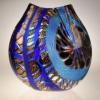
Murano Glass History - Pt 4 - 1910 to the Modern Day
After the breakup, Venini started Vetri Soffiati Muranesi Venini & Co., and hired Napoleone Martinuzzi, a sculptor who was overseeing the Murano Glass Museum, to manage his new venture. Martinuzzi developed pulegoso technique, and in 1930, helped bring forth the controversial use of opaque glass, something never seen in the centuries of Murano glass craftsmanship. The use of opaque glass proved to be a watershed event, since it completely broke with tradition, allowing the artists to experiment with different creative ideas that would have been considered absurd a few years prior.
Giacomo Cappellin also opened a new furnace, Maestri Vetrai Muranesi Cappellin & Co., and retained Vittorio Zecchin as director. Vittorio Zecchin remained director at Maestri Vetrai Muranesi Cappellin & Co., until 1926 when an unknown architect, Carlo Scarpa, replaced him.
The first few years under Scarpa were heavily influenced by Zecchin’s designs, but Scarpa didn’t take long to find his muse and produced many high quality pieces which made use of forgotten techniques, bright colors and opaque glass. Although Cappellin & Co. was considered an exceptional furnace; it closed in 1932 due to fiscal mismanagement. In a stroke of good fortune for Paolo Venini, Martinuzzi’s departure from Venini in 1932 to form Zecchin-Martnuzzi glass with Francesco Zecchin allowed him to pick up Carlo Scarpa as art director, who was looking for work after the closing of Maestri Vetrai Muranesi Cappellin & Co. Scarpa’s innovative techniques flourished during his tenure at Venini & Co. In addition to creating new ways to work with molten glass such as sommersi, he also developed new surface treatments including a corrosi, battuto, a fasce and a pennellate. During these years, Paolo Venini also took more of an active role in the day to day operations of a glass house and began co-designing works with Scarpa.
After departing Venini in 1947, Carlo Scarpa returned to architecture, restoring the Castelvecchio in Verona to wide acclaim, before passing away in 1978. Also during the 1930’s another artist, Ercole Barovier rose to prominence in Murano after he and his brother, Nicolo took over the creative direction of Vetreria Artistica Barovier. In 1939, after the brothers went their separate ways, the company was renamed Barovier & Toso Co., after a merger with the Toso family, and remains so named to this day. Ercole Barovier was known for his work with a murrine and the creation of beautiful sculptured animals. He spent much of his time during the 30’s perfecting a technique he named colorazione a caldo senza fusione, and also created fresh pieces in the 40’s and 50’s using the tessere technique.
In 1996, The Barovier family was recognized by the Guinness Book of World Records for being the oldest glass making family in the world. Also during the 30’s Ermanno Toso changed the direction of Fratelli Toso, which had been founded in 1854 by his ancestors, from one of creating traditional Muranese objects to one of one of more modern tastes. Again, war threatened the glass masters in the 40’s but the industry managed to survive World War II and emerged post- war with pent up artistic energy, making the 1950’s some of the most creative and innovative years the island of Murano have ever seen. The filigrana technique was expanded and used to new effect by another Murano master, Archimede Seguso, who opened his own shop, Vetreria Archimede Seguso, in 1946. Today, the works created during this time are considered the most desirable by collectors.
Artists including Dino Martens, who brought traditional Venetian techniques to America, Flavio Poli and Fulvio Bianconi all began making unique, non-traditional works to express their creativity. Since the 1950’s the mastros in Venice have collaborated with artists worldwide, including Pablo Picasso, Henry Moore and Jean Cocteau in addition to serving as a mentors to artists who started the American Studio Glass movement. A recent challenge to the Venetian glassblowers in the marketplace has been counterfeiting. Beginning in the 1990’s and continuing today, many of the classic vases, glassware and millefiore objects are being counterfeited in Asia, for sale overseas.
In September 2002, in response to this growing problem, Promovetro, the glassmaker’s consortium registered a Murano trademark with the European Union. The mark, a lilac colored sticker with a glassmaker’s cana de soffio (blowpipe) and the Italian inscription “Artistic Glass Murano” is printed on a film that is difficult to replicate or counterfeit.
Visit our website at http://www.italiandecor-glasslights.com for more information
